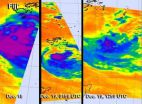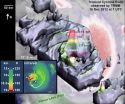(Press-News.org) JUPITER, FL, December 19, 2012 – Scientists from the Florida campus of The Scripps Research Institute (TSRI) have developed the first synthetic compound that can reverse the effects of a serious metabolic condition known as fatty liver disease. True to its name, the disease involves an abnormal buildup of fat in the liver.
The compound—known as SR9238—is the first to effectively suppress lipid or fat production in the liver, eliminating inflammation and reversing fat accumulation in animal models of fatty liver disease. The new compound also significantly lowered total cholesterol levels, although precisely how that occurred remains something of a mystery.
"We've been working on a pair of natural proteins called LXRα and LXRβ that stimulate fat production in the liver, and we thought our compound might be able to successfully suppress this process," said Thomas Burris, a professor at TSRI who led the study, which was recent published in an online edition of the journal ACS Chemical Biology. "Once the animals were put on the drug, we were able to reverse the disease after a single month with no adverse side effects—while they ate a high-fat diet."
Fatty liver, which often accompanies obesity and type 2 diabetes, frequently leads to more serious conditions including cirrhosis and liver cancer. The condition affects some 10 to 24 percent of the general population, according to a 2003 study in GUT, an international journal of gastroenterology and hepatology.
Burris and his colleagues designed SR9238 so that it would be quickly metabolized in the liver to minimize migration of the drug into the bloodstream, which could lead to side effects.
In the study, mice were fed a high-fat diet for 14 weeks prior to treatment with SR9238. After one month of treatment, the scientists found that the liver's fat-producing genes were repressed and fat expression in the liver was reduced up to 90 percent.
In addition, the scientists observed an 80 percent reduction of the enzyme responsible for producing cholesterol (3-Hydroxy-3-methylglutaryl coenzyme A Reductase)—the same enzyme targeted by statins.
Markers for liver damage were down as well, which suggests the compound may also have the potential to treat alcohol-related fatty liver damage.
INFORMATION:
The first author of the study, "A Liver Selective LXR Inverse Agonist that Suppresses Hepatic Steatosis" is Kristine Griffett of TSRI. Other authors include Laura A. Solt, Bahaa El-Dien M. El‐Gendy and Theodore M. Kamenecka, also of TSRI. For more information on the paper, see http://pubs.acs.org/doi/abs/10.1021/cb300541g
The work was supported by the State of Florida.
Scripps Florida scientists develop new compound that reverses fatty liver disease
2012-12-20
ELSE PRESS RELEASES FROM THIS DATE:
Regular marijuana use by teens continues to be a concern
2012-12-20
Continued high use of marijuana by the nation's eighth, 10th and 12th graders combined with a drop in perceptions of its potential harms was revealed in this year's Monitoring the Future survey, an annual survey of eighth, 10th, and 12th-graders conducted by researchers at the University of Michigan. The survey was carried out in classrooms around the country earlier this year, under a grant from the National Institute on Drug Abuse (NIDA), part of the National Institutes of Health.
The 2012 survey shows that 6.5 percent of high school seniors smoke marijuana daily, up ...
School shootings: What we know and what we can do
2012-12-20
Since the early 1970s school shootings at American elementary, secondary and higher education institutions have been a painful reality for American society. After each incident – like the recent attack in Newtown, CT – there is voluminous dialogue about what can be done to prevent the next, such tragedy. But can anything realistically be done to prevent these horrific crimes? A new article¹ by Dr. Daniel J. Flannery at Case Western Reserve University, and colleagues, scheduled to appear in the January issue of Springer's Current Psychiatry Reports, attempts to parse out ...
Alzheimer's disease: Cutting off immune response promises new approach to therapy
2012-12-20
The Bonn site of the German Center for Neurodegenerative Diseases (DZNE) and the University of Bonn are leading contributors.
The complex named "NLRP3 inflammasome" is composed of several proteins and plays a key role in the immune system. It resembles a fire alarm sensor that triggers a chain reaction when activated. As a result, immune cells are mobilized and substances that foster inflammation are released. This process can be triggered by infections, which are subsequently suppressed by the immune response. However, in the case of Alzheimer's disease, the activation ...
Impact of caring for adult child with disability studied
2012-12-20
The study, published in Psychiatric Services, highlights economic and psycho-social challenges faced by parents of adult children with disabilities, compared with parents of children without disabilities.
When either parent becomes disabled, the study found, families' report lower financial well-being. This being especially true when an aging parent must contend with both the needs of an adult child with mental illness and a spouse who develops an age-related disability.
Not surprisingly, parents are themselves susceptible to developing disabilities and chronic conditions ...
Super-fine sound beam could one day be an invisible scalpel
2012-12-20
ANN ARBOR—A carbon-nanotube-coated lens that converts light to sound can focus high-pressure sound waves to finer points than ever before. The University of Michigan engineering researchers who developed the new therapeutic ultrasound approach say it could lead to an invisible knife for noninvasive surgery.
Today's ultrasound technology enables far more than glimpses into the womb. Doctors routinely use focused sound waves to blast apart kidney stones and prostate tumors, for example. The tools work primarily by focusing sound waves tightly enough to generate heat, says ...
Pigs in southern China infected with avian flu
2012-12-20
Researchers report for the first time the seroprevalence of three strains of avian influenza viruses in pigs in southern China, but not the H5N1 avian influenza virus. Their research, published online ahead of print in the Journal of Clinical Microbiology, has implications for efforts to protect the public health from pandemics.
Influenza A virus is responsible both for pandemics that have killed millions worldwide, and for the much less severe annual outbreaks of influenza. Because pigs can be infected with both human and avian influenza viruses, they are thought to ...
Transplanted neural stem cells slows als onset and progression in mouse models
2012-12-20
WORCESTER, MA – Promising new research provides evidence that ALS, amyotrophic lateral sclerosis (ALS), also known as Lou Gehrig's disease, may be treatable using neural stem cells. A consortium of researchers at multiple institutions, including the University of Massachusetts Medical School, Sanford-Burnham Medical Research Institute and Brigham and Women's Hospital, have shown that neural stem cells, when transplanted into the spinal cord of a mouse model with familial ALS, slow disease onset and progression while improving motor function, breathing and survival time ...
Study reveals that animals contribute to seagrass dispersal
2012-12-20
(December 19, 2012) Look out the window and you're likely to see the dispersal of seeds—dandelion tufts in the wind, a squirrel burying an acorn, a robin flying off with a dogwood fruit. You might even have a burr "velcroed" to your sock.
Sarah Sumoski, a recent graduate of the Virginia Institute of Marine Science, has now published a study of seed dispersal in a less-familiar environment—the eelgrass beds of Chesapeake Bay. The study—the first to show that marine animals can disperse eelgrass seeds—appears as the featured article in today's issue of Marine Ecology Progress ...
Time series of infrared NASA images show Cyclone Evan's decline
2012-12-20
Cyclone Evan is now far south of Fiji and wind shear and cooler sea surface temperatures have been taking their toll on the storm and weakening it. Infrared data from NASA's Aqua satellite has shown a quick decline in the storm's structure over one day.
A time series of infrared images from the Atmospheric Infrared Sounder (AIRS) instrument that flies aboard NASA's Aqua satellite showed changes in intense thunderstorms within Cyclone Evan between Dec. 18 and Dec. 19. Over a time period of 36 hours, Evan weakened from Cyclone strength to Tropical Storm strength. In an ...
NASA satellite finds an unusually tall storm-cell in Cyclone Evan
2012-12-20
NASA's Tropical Rainfall Measuring Mission or TRMM satellite found an unusually tall towering thunderstorm in Cyclone Evan.
According to Owen Kelley of the TRMM satellite team at NASA's Goddard Space Flight Center in Greenbelt, Md, the most startling feature of the December 16 overflight of Tropical Cyclone Evan was the extremely tall storm-cell in the north side of the eyewall. At the time TRMM passed overhead and captured an image of the storm, Evan was about to rake across the northern coast of the islands of Fiji.
The updrafts in this tower extended high enough ...



